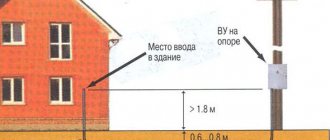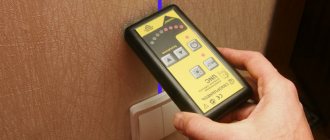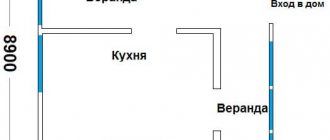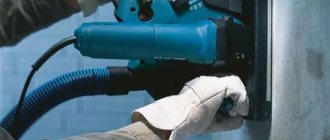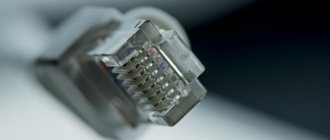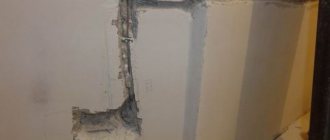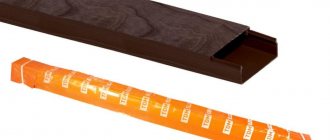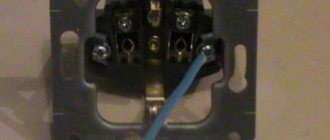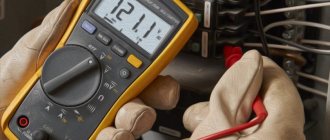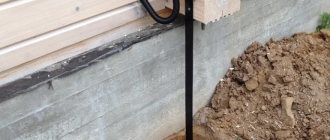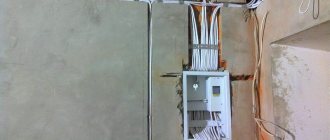Drywall is used to level walls and ceilings. It can be attached to the base using adhesive or mounted on a metal frame. This determines how the installation of electrical wiring under the drywall will be carried out. Let's look at how to do this step by step, as well as the nuances of laying wires in a plasterboard ceiling and bathroom.
Features of installing wiring under drywall
The wiring may be accidentally damaged by the profile or self-tapping screws, and therefore a short circuit may occur. To prevent this from happening, the conductor must be laid in a corrugated pipe; moreover, it will not allow the flame to spread in the event of a fire in the wiring behind the sheets of drywall.
Inexperienced electricians may not know how to pull a cable into a corrugated pipe. You can do it like this. A hole is made at the end of the wire. Then a string of corrugated pipe is threaded through it and fixed. Next, you need to tighten the string until the wire of the required length enters the pipe.
When installing wiring under drywall, not only corrugation can be used, but also pipes or special boxes. However, these materials are not very comfortable. Corrugated pipe has such advantages as a small diameter and good flexibility. Therefore, it is recommended to use it.
How to conduct wiring if the gypsum board is attached to the frame
First you need to make a frame from profiles, but there is no need to attach gypsum boards to it yet. Then you can install the wiring in the drywall.
To carry out the work you will need the following materials:
- Cable of the required section. It is better to lay non-flammable VVGng
- Corrugated pipe of suitable diameter
- Clips for attaching corrugated pipe to the base
- Fasteners for fixing clips to the wall
- Distribution boxes
- Sockets
- Switches
- Socket boxes for drywall
- Terminal blocks for connecting wires
It is also necessary to prepare a hammer drill and a crown with a diameter of 65 mm for making holes for the socket boxes.
Next, install the wiring in the following sequence:
- An electrical wiring diagram is drawn indicating the location of all elements. It should be taken into account whether the cable will be laid along the walls or the ceiling. If you plan to install a suspended or suspended ceiling, then it is more rational to run electrical wiring along it and lower it perpendicular to the floor to switches and sockets. If only the walls are covered with plasterboard, and there will be no structures on the ceiling, then the wiring should be carried out along the walls, 10-15 cm away from the ceiling;
- The diagram is transferred to the walls;
- Distribution boxes are installed in accordance with the electrical diagram. They are fastened using self-tapping screws;
- Next, according to the markings, clips are attached at a distance of 30-40 cm from each other. The clips can be replaced with plastic clamps, which speed up the wiring installation process. But there is a possibility of damage to the corrugation on the sharp edges of the profile;
- A corrugated pipe with a wire in accordance with the diagram is pulled through a frame of metal profiles. Holes are pre-drilled in the profile, matching the diameter of the corrugated pipe, or you can purchase a profile already prepared for installation of wiring;
- Drywall is attached to the metal frame. It is important to remember the location of the cable ends routed for sockets and switches;
- Sockets and switches are installed and connected. In accordance with the diagram, holes are made in the drywall using a drill with a crown installed on it. If calculated correctly, the input wires will be located exactly opposite them. Next, the cable is pulled out through the socket box, and the socket box is inserted into the place prepared for it and fixed using the screws on the sides. Sockets and switches are connected.
Installation of switches and sockets should be carried out after completion of the repair, then the new decorative trims will remain clean.
How to save money
Here are some practical recommendations that will allow you to install electrical wiring while spending a minimum of financial resources:
- Avoid purchasing cheap materials, including cable, corrugation, fasteners, socket boxes and boxes. Poor quality will lead to the fact that the wiring in the drywall will fail after 2-3 years. In the worst case scenario, electrical appliances may break down. Rewiring is a complex process that requires removing some sheets of drywall.
- Take your time and make sure the quality and reliability of the system. Separate power and lighting lines.
- If you replace the cable, check that the old wiring is in good condition. If all is well, you can leave the circuit that was used. In addition, some parts of the wiring may not need to be replaced.
- The cable cross-section is calculated depending on the load it must provide. At the same time, it is important to make a certain reserve. You can't know what you'll want to use 1-2 years from now. The reserve in cross-section will allow you to play it safe and avoid the need to replace the wiring.
- If you don't want to drill holes for sockets, use overhead hardware.
Installing an overhead socket on drywall
Remember that the open method of wiring on drywall violates all electrical and fire safety rules. Therefore, it is not used in this case. Do not forget to turn off the circuit breakers before installing or replacing the cable. All electrical installations (sockets and switches) should be installed at the very end. This approach will prevent damage to the decorative part.
How to conduct wiring if the gypsum board is attached with glue
Now let's look at how to make wiring under drywall, which is attached with adhesive. This method requires cutting the wall.
Installation work is carried out in the following sequence:
- The location of all elements is marked on the wall. To avoid distortions, it is recommended to use a level. Turns of wires must be made as smooth as possible;
- Next, according to the markings, the walls are chipped. Using a hammer drill with an installed crown of the required diameter, holes are drilled for sockets and switches. Their depth should be more than 35 mm. Cable laying grooves can be made with the following tools:
- Chisel and hammer. Squeezing out the groove with them is quite labor-intensive
- Drill and chisel. Holes are drilled every 1-2 cm with a drill, then everything else is knocked out with a chisel. This method will not work to make a groove in a brick wall.
- Grinder with a diamond blade. A lot of dust is generated
- Hammer. The grooves turn out crooked
- A wall chaser is a tool for creating grooves
- The wire is pulled through the protective pipe;
- A corrugated pipe with a wire threaded through it is placed in grooves made in the wall. The wiring leading out for connecting sockets and switches must be open;
- The grooves are sealed with putty.
Having completed the installation of electrical wiring, you can begin gluing plasterboard sheets.
Laying electrical wiring when gluing gypsum boards
Before running a wire under drywall in this way, it is necessary to take into account that due to the use of an adhesive composition instead of constructing a frame, there is extremely limited free space between the sheets and the surfaces to which they are fixed, which is why it is necessary to drill through the wall to pull the cable through.
It is best to resort to an electric tool designed for this task, for example, an angle grinder, a hammer drill or a wall chaser, especially if there is a huge amount of work to be done. Using a hammer with a chisel and other hand-held devices in such a situation is too labor-intensive and it is optimal to resort to their use only when there is a small number and insignificant length of grooves created for wiring.
To increase the comfort of work, before making grooves, a previously drawn up plan should be marked on the surface of the walls, as is the case with the frame being erected, and then you can begin to implement them. The creation of grooves must be done with strict adherence to the markings.
In places that are selected for future distribution boxes, sockets and switches, holes must be made with a crown of a suitable diameter or other special tool. If the work is carried out in a wooden house, then it is better to create it using a chisel.
At the end of the gating process, it is necessary to install distribution boxes, and lay the wire previously placed in the corrugated pipe into the grooves, using plastic clips to fix it. Finally, you need to fill the recesses with plaster.
After the mixture has hardened, you can begin gluing the drywall, and then install sockets and switches, having previously made holes of the appropriate diameter in the places with previously routed cables.
Note! To avoid damage to the finish, all work related to electrical wiring must be completed before it.
How to carry out wiring if repairs have already been made
Sometimes, after installing drywall, people realize that an additional outlet or switch is needed.
If the ceiling is open and there are no structures on it yet, then installation of electrical wiring in plasterboard is carried out as follows:
- The required hole is made;
- A thread with a heavy nut tied to it is taken and lowered from the ceiling above the future outlet. The nut on the thread should fall to its level;
- Using electrical tape, a cable is attached to the upper end of the rope. Then the rope is pulled from below until the wire appears in the hole.
If the repair is complete, the following steps must be followed to install the wiring:
- A hole for the socket is drilled in the drywall;
- The smallest piece of plasterboard sheet is located and dismantled. An open space is created that will allow you to stretch the corrugated wire;
- If the open space is at the bottom, then the cable is pulled from the hole down, and if at the top, then to the hole. A transverse profile can interfere with the passage of wiring, so a wire or rope suspension is used.
In this way, you can install missing electrical elements when the repair is already completed.
Features of the work
Since there is no universal method for installing electrical wiring under plasterboard sheets, the main methods will be discussed below. In any case, you should start by drawing up a detailed diagram. The locations of the sheets themselves, joints and screws for fastening are indicated on the walls.
Any socket or switch must be installed at least 200 mm away from the edge of the drywall. The requirements are similar when working with metal profiles, so installation lines are calculated with an eye to future installation. After this, they begin to take measurements and transfer the diagram onto paper. Having completed all the steps, upon completion of the installation of the gypsum board, you will know where to lay the communication elements.
Cable wiring and installation of the frame under the gypsum board
Electrical wiring in a plasterboard ceiling
If only one lamp is planned, then the cable should be laid to the upper edge of the walls. Holes are made in the plasterboard ceiling opposite each other in a straight line. An electrical cable is inserted into one of them and moved to the other. This method allows you to stretch it several meters.
If several lamps will be installed, the work must be carried out before attaching the drywall to the frame. If the sheets are already mounted, they will have to be removed.
Let's look at how to stretch a cable under plasterboard on the ceiling:
- A wiring diagram is drawn, on which all points of distribution of electrical elements are marked. Next, markings are made on the ceiling;
- According to the plan, the cable is attached to the ceiling using clips or perforated metal tape;
- The wires are connected to electrical points through installed socket boxes.
On a plasterboard ceiling, you can install light spotlights that are light in weight and have almost no impact on the suspended structure.
Placement of sockets and switches
To install sockets and switches, you will need a drill with a special attachment for drilling drywall to make holes in the places where you left the ends of the wires. Now you're glad you marked these places, aren't you?
Which is better: heated floors or radiators?
Warm floorBatteries
If the locations are determined correctly, then through the hole you will have access to the end of the electrical cable. The next step is to install a socket box into the hole. Cut holes in the bottom of the required diameter to pass the wires through. Pull the cable out from behind the drywall and insert the socket box into the groove. You will see screws on the sides of the socket box. They need to be tightened until the claws secure the socket body in the hole.
The last thing you need to do is to independently connect the sockets and switches to the general electrical wiring system. It is unlikely that anyone will not cope with such an easy task. At least not the person who decided to independently install electrical wiring under drywall. It is best to install sockets after the repair is completed. You will also be applying putty on top of the drywall and it will be extremely unsightly if it gets on the outer housing of the socket or switch.
Electrical wiring in the bathroom
A bathroom is a room with a high level of humidity, so wiring on a plasterboard wall must meet the following requirements:
- The distribution box must be located outdoors
- Sockets must be installed at least 65 cm from the water source
- All electrical elements must be of the moisture-proof type
- The line must be grounded
- Separate circuit breaker
- The grounding bus, pipes, drains, electrical appliances, heated towel rails must have a common potential equalization system
- It is recommended to install LED lamps
You should take a three-core copper cable with a cross-section of at least 2.7 mm2, intended for wet rooms. The wiring is installed under the ceiling. The cable runs strictly vertically to the sockets.
Now you know how to lay a cable in a plasterboard wall. It's not difficult to do this yourself. The main thing is to do everything correctly in compliance with all installation rules.
Liked? Share on social media networks!
Installation using plasterboard sheets (abbreviated as gypsum plasterboard, and in common parlance just plasterboard) helps hide wall defects, and is a cheaper method than leveling using other methods.
It is logical that cables, junction boxes, switches and sockets are hidden under drywall (this means special socket boxes - mounting boxes for switches and sockets). The easiest way to install electrical wiring is during the installation of gypsum boards, after installing the profiles, and before laying the drywall sheets.
Electrical wiring under the gypsum board is hidden
First, the cross-section of the cable wires (VVGng, VVGng-LS) of the electrical wiring is calculated based on the load, then the location of household appliances and switches is determined, and accordingly, the wiring branch nodes that will be made in distribution boxes are outlined.
Since electrical wiring and its components - cables, junction boxes, switches and sockets are hidden in plasterboard, such wiring is considered hidden, it must be laid in a corrugated material made of non-flammable material.
installation of cables in corrugations between profiles
Lay the corrugation in the space between the metal profiles and the wall. If the ceiling is also covered with plasterboard sheets, and spotlights are supposed to be installed in it, then it would be more logical to install electrical wiring on the wall under the ceiling, making wiring for lighting, lowering bends down to connect switches and sockets.
installation of wiring under the ceiling for lighting
The corrugation with the cable is attached using special clips attached to screws that are screwed into the dowels. The holes for the dowels are drilled using a hammer drill.
Clip fastening for corrugation
Features of installing electrical wiring under gypsum boards
Switches and sockets are placed in drywall at a normal height, so that they are convenient to use.
According to the PUE, access to distribution boxes must be ensured, so you should provide removable panels opposite the boxes, or use distribution boxes that are mounted in a plasterboard sheet using special paws, as well as a socket box designed for plasterboard.
Drywall installation box
Branch boxes must also be made of non-flammable material. In general, this electrical wiring is subject to the same requirements as hidden wiring, with the proviso that switches and sockets can be placed in drywall only by using special socket boxes specifically designed for these purposes.
space for distribution box
Electrical wiring protected by corrugation can be placed in profile structures. At the point where the cable passes through the profile, a hole is made in it, cutting radial lines along which petals are bent, which will protect the corrugation and cable insulation from rubbing against a sharp edge.
The use of corrugation is allowed if the walls (brick or concrete) on one side and the plasterboard on the other do not propagate combustion. For this reason, it is better to use a non-flammable type of drywall. If the walls of a wooden house are covered with plasterboard sheets, then corrugation is not allowed, only metal pipes.
Installing cables under drywall in a wall
Features of installation of a specific socket box
The socket for plasterboard differs from the usual one in that it has special spacers on the back side, with the help of which the cylinder of the socket is pressed against the back side of the plasterboard sheet.
Socket box for plasterboard with screw and spacer for fastening
This cylinder also has an edge on the front side, which rests against the outer surface of the sheet, preventing the socket box from sinking into the hole, which is drilled with a core drill. Thus, the socket box is clamped into the drywall between its two surfaces.
installing multiple sockets in drywall
The fixing tabs do not interfere when placing the socket box in the hole, but they rotate to the desired position after turning the tightening screws. The cable is pulled through a special hole in the back of the cylinder, which is broken out in the right place.
There are also socket boxes designed for a block of sockets; in this case, they are connected using special connectors through which the wires are pulled.
installation of socket boxes in plasterboard
Pulling the socket cable under the installed drywall
It is not necessary to dismantle all the sheets of drywall - you can get by with partial dismantling - not always a standard sheet of drywall stretches from the ceiling to the floor - installation from above or below is carried out using cut pieces, they need to be found and dismantled.
Their fastening profiles are found using a metal detector or a powerful magnet - the distance between them will have a different dimension. You can also tap - a smaller sheet will produce a higher sound.
After dismantling these sheets, a niche is formed in which it will be easy to stretch the corrugation with the cable. The hole for the socket is drilled in the plasterboard in the right place, and depending on where the plasterboard sheets were removed, the cable is lowered from the socket box hole (if a niche is formed at the bottom), or to the hole if partial dismantling is done at the top.
drilling a hole for a socket
The transverse profile can also prevent the cable from being pushed, so use a suspension on a strong thread or wire, tugging on it until it drops to the desired height, where the suspension is intercepted with your fingers.
Horizontal laying of the socket cable under fixed drywall
To lay a horizontal cable for connecting the socket, a special broach in the form of a metal string is pushed under the drywall. For these purposes, a real piano bass string or a specialized broach with a metal tip may be suitable.
This broach is pushed between the profiles and the wall, sometimes scrolling if it rests against the profile, moving towards the opening of the socket box. When the tip of the broach goes around the profile behind which the hole is located, the tip of the string may end up on the floor.
In this case, use a powerful neodymium magnet and look for the tip by moving the magnet in the intended location. The attraction of the magnet and the rustling of the broach will indicate that the magnetic field has captured the tip.
By moving the magnet towards the opening of the socket box, move the end of the broach, located on the back side of the plasterboard sheet. Having reached the hole, the string is intercepted with your fingers, the cable is attached to its other end using electrical tape and pulled through.
example of cable installation under drywall
In this way, you can connect the cable to any electrical outlet or box if the profile is not pressed close to the wall, even if the space is filled with insulation. In this case, the tip is guided with a magnet along the inner surface of the gypsum board and released when it reaches the profile.
The tip of the broach is made slightly curved, which allows it to pass through profile structures when the string rotates.
Electrical wiring in a plasterboard ceiling
The ceiling is covered with special ceiling plasterboard sheets, which are thinner to reduce weight.
Sometimes such sheets are mistakenly or intentionally (for the sake of economy) used for vertical installation. It is forbidden to install sockets in ceiling plasterboard if the wall is mounted from it - such material is thinner and may not withstand the dynamic loads that occur when plugs are plugged into an outlet.
Light spotlights with small dimensions are installed on the plasterboard ceiling, due to which they have virtually no effect on the entire suspended structure.
For these lamps, corresponding holes are drilled in the plasterboard sheets, after which the electrical wiring is installed.
Installation of a ceiling lamp under drywall
Installing wiring above the ceiling
The same string, or broach, together with a magnet helps to stretch the cable. You can pull the wiring from the connection point, or from the extreme hole, inserting a broach into it, throwing it through horizontal profiles towards the next hole, catching the tip with a magnet.
This method is more effective than using a metal ball with a thread - it will not jump over the profile. Using a broach, sequentially pull the wires along with the corrugation through all the holes. After that, the lamps are connected, and they can be installed in the holes by pushing the connected cable into the void of the ceiling.
Similar articles
When carrying out repairs or finishing walls, sheets of plasterboard are increasingly used. If we ignore the small drawback of reducing the size of the room due to the thickness of the material, this method is the most convenient: it is not as labor-intensive as covering the walls with plaster.
If you decide to choose this option for finishing, you need to know how to properly lay electrical wiring under false walls.
There are 3 main methods of installing gypsum boards on the wall, each of them involves different ways of organizing energy supply.
- Gluing sheets to the wall using adhesives. Not much different from simple plaster, but laying the wire into the wall is somewhat easier. But installing socket boxes in drywall in this case is a more difficult task.
- Installing drywall on metal profiles without an insulating gasket. The cable is laid in the space between the base wall and the gypsum board.
- Installation of sheets on profiles, but heat and sound insulation is laid under the drywall. In this case, the cables are laid in a special way, taking into account the selected insulation material.
In cases 2 and 3, installing sockets in drywall is not difficult.
There is another option. It is non-standard, but occurs quite often:
The room is already finished with plasterboard, there is a decorative coating (paint, wallpaper), and there is an electrical network with sockets and switches. And you needed to install several more connection points (220 volt sockets, Ethernet local network, cable for TV). Is it possible to carry out the work without damaging the finishing layer? If you have a diagram for fastening drywall sheets, no problem.
Option with corrugated hose
A clear advantage of this approach is the ease of replacing cables if they suddenly fail. The necessary components will be: the corrugated hose itself, clips that will hold it, distribution boxes, electrical cable, dowel-nails (the clips are attached to them), a hammer drill and a drill for it.
Before starting any work, be sure to evaluate how current-consuming devices are located in the room.
When thinking through the system configuration, they also pay attention to the power of each of the target nodes. The diameter of the corrugation is selected according to the thickness of the cables being installed
The next stage of work consists of attaching the corrugation to the wall, followed by covering it with profile frames.
To facilitate fastening, the wall is covered with holes at intervals of 300-400 mm. It is at these points that it is convenient to pin the clips with dowel nails. During the installation process, you need to ensure that the cable does not sag anywhere. When marking the future electrical network, first of all, mark the points where distribution boxes, sockets and switches will be installed. When it is known that the ceiling will be closed, it is advisable to extend the wiring from one box to another there.
The distribution along the walls runs strictly 0.15-0.2 m below the ceiling, and distribution boxes are placed on the same line. These boxes themselves must be carefully selected - the lid must meet a certain level of protection, which is prescribed by codes for branching electrical wiring in cavity walls.
Running the cable into the corrugation begins from the boxes, maintaining the vertical as clearly as possible towards each of the switches and lamps in the room. The same trajectory should be used when connecting distributors to sockets.
Experts recognize the fireproof cable of the VVGng series as the best option for laying in plasterboard. It is suitable even in a wooden house. It is also advisable to buy special socket boxes for drywall and terminal blocks that make it easier to connect wires. It is recommended to use a drill with a cutter with a caliber of 6.5 cm - just this format will allow you to securely fit the socket boxes into the grooves.
Tools and materials
The list shows all possible accessories. You can reduce their number while ensuring general fire and electrical safety.
- Corrugation for laying cables. Desirable for installation between gypsum boards and the base wall. Can be plastic or metal. The latter is used if the insulation is made of a material that supports combustion.
- Instead of corrugation, you can use a cable box, but this is overkill from a cost point of view.
- Power cable. When laying in corrugation, one layer of insulation is allowed; if the wiring is without corrugation, the insulation must be three layers.
- When installing into a base wall (grooving), double insulation is sufficient.
- Grounding cable to create an additional potential equalization system. Profiles under drywall should be grounded.
- Accessories for fixing the cable (corrugation): clips, plastic bushings for holes in the profile, ties.
- Installation boxes for drywall or regular installation boxes if the gypsum boards are glued to the wall.
- A device for making holes in profiles and drywall - so-called “ballerinas”, or crowns. Of course, a drill.
Features of installing wiring under gypsum boards
There is no universal technique, so we will consider technologies depending on the method of laying sheets. Installation of electrical wiring under drywall begins with drawing up a detailed plan. The proposed locations for laying gypsum boards are marked on the wall, taking into account joints and the possible use of fastening screws. Installation points for sockets and switches should be planned at a distance of at least 20 cm from the edge of the sheet. The same requirements apply to metal profiles. Profile installation lines are also calculated taking into account cable routing.
Then measurements are taken and the plan is transferred to paper. After installing the drywall sheets, you won’t have to look for all the communications at random.
Plasterboard glued to the wall
Since this method is not much different from ordinary plaster, cable laying is done in the same way. Grooves are made in the walls. The laying depth may be less than with plastering, but between the cable sheath and the inside of the gypsum board there must be a layer of putty of at least 5 mm. It is not advisable to lay sheets directly on the wiring. Drywall is less durable compared to plaster, and there is a risk of mechanical damage to the cable.
Next, we choose the method of installing socket boxes in drywall.
- If the box is fixed on a sheet, a recess is made in the base wall with a margin of at least 2 cm in diameter. In this case, there are no difficulties with laying the cable: it is walled up in the groove, the mounting end is laid in a ring at the bottom of the recess as deep as possible. This is done in order not to damage the wire when drilling a hole in the gypsum board.
The hole is made carefully, as soon as the circle is separated from the sheet, the drill stops. The free end of the cable is threaded into the hole in the box, and the socket box is fixed in the drywall.
Important! When gluing drywall to the wall, you need to make sure that in the area where the box is installed there is no mounting adhesive (plaster) within a radius of 20 cm from the center of the hole.
Otherwise, the technological grooves for the installation screws will be bricked up, and you will not be able to screw the box.
- When using conventional mounting boxes (under alabaster), the technology is similar. Only the hole in the gypsum board is drilled in advance, according to the markings. The diameter is 10–15 mm larger than the size of the socket box. The cable is laid as usual, with a margin for connection. Before installing the sheet, drywall adhesive is applied around the recess in the base wall. After installing the gypsum board, the excess plaster is removed, the hole is monolithic, without a gap between the wall and the drywall.
After which the box is placed on the alabaster, as in an ordinary plastered wall.
Drilling holes for boxes with recesses into the base wall after gluing drywall is undesirable. There is a 100% chance that you will damage the prepared cable.
Drywall is mounted on metal profiles without insulation
In this case, the wiring is laid in random order between the drywall and the wall.
Holes are made in the metal profile. The edges must be sanded to prevent damage to the insulation. Then the cable is pulled according to the prepared diagram.
Regardless of whether the cable is laid with three-layer insulation or is corrugated, when pulling through the profile, it is advisable to install bushings in the holes. It can be made from scraps of polypropylene pipe.
Important! The intersection lines of the cable and the profile must be marked on the diagram. Self-tapping screws that are screwed into drywall should not be located closer than 10 cm from the cable.
Otherwise, the screw may get caught in the cable and cause a short circuit. Or, through a screw, a phase may get onto the entire profile frame (another argument in favor of grounding the profile).
For the same reason, electrical wiring under drywall should be located as far away from the drywall as possible.
Installation of sockets in drywall is carried out in the usual way.
The safety measures are simple: before installing the slabs, the wiring should be taken away from the place where the hole is supposed to be drilled. Then it will be easy to find it through the hole under the box.
Another way to lay the cable is to secure it to a load-bearing wall using clips. In this case, you can fix the profile on the wall with technological gaps through which the wire will pass. The likelihood of damage in this case is minimal. Of course, all profile breaks must be marked on the markings so as not to screw screws into the void.
Vertical installation is even simpler: the cable is attached to the profile using clips or nylon ties.
Insulation is laid between the gypsum board and the base wall
The installation technology is the same as in the previous case, but with mandatory compliance with fire safety measures. If mineral wool or other non-combustible material is used as an insulating material, there are no additional requirements. The insulation is simply placed neatly around the cable. If the material is fire hazardous, the cable is laid in a corrugated metal or plastic material that does not support combustion. Installation of bushings is desirable, as in the previous section.
The same rules apply when laying cables behind drywall in a wooden house. The rules for electrical installations also provide for the laying of steel pipes into which the wiring is inserted.
Sandwich: wall - glue - insulation - glue - drywall
When using rigid insulation, which itself is a structural material, a metal profile is not required. In this case, installation of wiring in plasterboard is carried out along the load-bearing wall. The insulation is glued with an air gap, or channels for wiring are cut out in it.
Sheets are glued on top of the insulating material. If the thickness of the sandwich allows, installation of socket boxes in plasterboard is carried out with fastening to a load-bearing wall.
Frame covering
For covering the frame, plasterboard sheets with a thickness of at least 12.5 mm with a side chamfer are suitable. The latter makes it possible to reinforce joints with self-adhesive sickle and fill them with high-strength putty.
By the presence of a bevel, as if by a marker, the front side of the sheet is determined. Each of them is screwed to three support posts: two at the edges and one in the center. In this case, the joints of the sheets pass in the middle of the profile. In wet rooms, moisture-resistant plasterboard (GKLV) is used instead of conventional panels.
You can learn more about the types and choice of drywall from another article.
If there is no factory chamfer, for example, when using drywall scraps, you must make the chamfer yourself using a construction knife and a special grater (plane):
When sheathing a partition with two layers of plasterboard, the sheets of the second row are shifted horizontally by a stud spacing, and vertically by at least 400 mm; a similar shift of sheets is also made when installing the first row of plasterboard, but on the reverse side of the structure.
Layout of plasterboard sheets for a two-layer partition sheathing
When constructing a partition with a height of 3.0 m or less, as a rule, there are no horizontal joints of the sheets.
To create a gap at the floor, the sheets are supported on a temporary spacer 10 mm thick and secured with self-tapping screws.
By trimming the top edge, a gap is obtained at the ceiling (10 mm wide). Both gaps help protect the structure from premature destruction.
It is important to ensure that the beveled edges of the mounted sheets are located in the center of the racks, the shorter edges are located along the axis of the crossbars, and the sheathing seams do not meet at the corners of the door frame. When fastening sheets of drywall with self-tapping screws, you should adhere to the following rules:
When fastening sheets of drywall with self-tapping screws, you should adhere to the following rules:
- The distance between the screws should not exceed 250 mm (but with two-layer sheathing for the first row, this value can be increased to 750 mm);
- The self-tapping screw must be screwed into the profile at a right angle;
- The screw head should be recessed into the gypsum board sheet by 1 mm and not tear the cardboard;
- The body of the self-tapping screw must enter the metal structure by at least 10 mm;
- The vertical displacement of screws on adjacent sheets must be at least 10 mm;
- When installing self-tapping screws, it is necessary to deviate at least 15 mm from the longitudinal edge of the sheet, and 10 mm from the end edge.
The photo above shows that the distance between the screws should be no more than 250 mm, and the offset of the screws on adjacent sheets should be no less than 10 mm
On the left is the correct position of the screw in the sheet of drywall, on the right is the incorrect position of the screw: a) the screw is twisted at an angle b) the screw is set too deep c) the screw is not set deep enough
The chamfers of the sheets are joined in the center of the racks, and the short edges of the panels are joined along the axis of the lintels. If the joints of the latter coincide, then the longitudinal line of the cross-shaped seam will become a source of crack formation. And no amount of finishing, even the highest quality, will help here. Therefore, they are joined with a seam spacing (with shifting) of at least 40 cm.
To cut a sheet of drywall, you need to lay it on a flat surface and use a pencil to mark it. A construction knife with replaceable blades is used to cut the top layer of cardboard. Then the sheet must be turned over and carefully broken along the cut line. Then the cardboard is cut through the second side of the sheet (photo below):
Immediately after covering the frame on one side, you can start drilling holes (Ø35 mm) in the profile posts. They will be useful for those who lay electrical cables inside the wall. To prevent the sharp edges of the slots from damaging the braid, they are bent, and the wiring itself is laid in a corrugation.
Also on the building materials market there is a profile with ready-made holes for laying communications.
Holes for sockets and switches are cut using round crowns. You can read more about this here.
Laying additional wiring for ready-made gypsum board finishing
How to stretch the wire and install a socket box under the mounted drywall? It all depends on what is between the wall and the sheets.
- If the drywall is glued to the wall, you will have to cut through the finishing surface and make shallow grooves. In this case, it will be necessary to restore the front layer (paint or glue a strip of wallpaper).
- When mounted on a profile, the task is simplified. Of course, you need to know the layout of the metal guides. In order not to spoil the upper part of the wall, the power cable can be routed from below, from under the baseboard. First, a hole is drilled for the socket box. Then, the plumb line determines the location of the cable entry (the plinth in this place is temporarily dismantled). A rope with a plumb line is lowered into the prepared hole, which is pulled out from the lower hole for entering the cable. The wire is attached to a rope and pulled up.
Next is the usual scheme: installing the box in any way. The input cable is pulled under the baseboard to the distribution panel.
- If there is soft insulation between the drywall and the wall, you can use steel wire instead of rope (which remains after installing the corrugation). This method does not work with rigid insulation boards.
Considering the uncontrolled position of the cable under the plasterboard, it is recommended to use corrugation. As a last resort, a wire with three layers of insulation.
After installing additional wiring, be sure to make changes to the current power supply circuit. Otherwise, during repairs you will damage the new cable.
Electrical wiring and bad sound insulation
The last question remains, about the proximity of the sound insulation layer in the drywall frame and electrical wiring.
Everything is simple here. In places where mounting and junction boxes are installed, the sound insulation layer must be compressed to a thickness of 30 mm. Electrical wiring pipes are laid over a layer of sound insulation. This is why all instructions from drywall manufacturers recommend using mineral wool rather than foam plastic for sound insulation.
Electrical installation
Hardware and metal frame slats are potentially dangerous for the materials from which the cable sheath is made. Therefore, wiring under drywall requires protective mechanisms.
Electrical wiring under drywall
For this purpose, pipes, cable and corrugated channels are used. A corrugated tube is a frequently used product that can eliminate the occurrence of a short circuit in the network. Its popularity is due to its high elasticity and small cross-section. To thread the cable into the corrugation with your own hands, first pierce its edge with an awl. Do this carefully, without touching the wires. Then a string of the corrugated channel is threaded into the resulting hole and fixed. Then, by pulling the string, a cable of the required length is inserted.
Installation with adhesive fixation of drywall
Wiring in plasterboard depends on the method of fixing the plasterboard sheets to the base: installed on an adhesive or mounted to a metal frame.
In the first case, in order to lay the cable under the drywall, the walls of the room are grooved for electrical wiring. It’s not difficult to do grooves with your own hands if you have the tools and equipment:
- Chisel and hammer - the groove is knocked out with tools, this is a labor-intensive method, but not expensive;
- Drill and chisel - holes are made in the wall in increments of 1-2 cm, then the jumpers are knocked out with a chisel, not suitable for brick walls;
- A grinder with a diamond blade has the disadvantage of strong dust formation;
- Hammer – the downside is the curvature of the groove;
- A wall chaser is a special tool that provides the greatest efficiency.
Wiring example
Cable laying methods
There are several options and you need to make the final choice in favor of one or the other depending on the method of fixing the gypsum board to the wall. Today, you can level walls with plasterboard by fixing the material to a frame made of metal profiles or wooden blocks. Otherwise, you can avoid its construction by resorting to the use of special adhesive compositions, but this method is preferred much less frequently, since before fixing the plasterboard sheets to the walls, their evenness must be brought to an almost ideal state in advance, if it is not such initially. Also, when fixing gypsum boards with glue, it becomes more difficult to lay cables. The reason is that there is a preliminary need to groove a wall or several under them.
In such a situation, it is necessary, using a hammer drill or other tool suitable for this task, to create grooves in which the wiring will be laid. After fixing the cables in them, the recesses should be sealed with plaster. Once it has completely hardened, you can begin gluing the drywall.
Taking this into account, in most cases, if there is a need to secure the material to the walls, a frame is still constructed from a metal profile, which is why the method that is suitable for it should be considered in more detail first.
Installation of wiring under a plasterboard structure
The first stage of electrical work is the implementation of a detailed schematic wiring plan. It determines the exact position of points and nodes: sockets, switches, lamps, blocks and distribution boxes. The finished diagram is transferred to the walls.
If there is not enough experience to carry out the plan yourself, use a standard solution or a specialized computer program.
Calculate the amount of materials needed:
- Terminal blocks for connecting wires;
- Corrugated tube with the cross-section parameters required for the wire;
- Clips for fixing the corrugation;
- Sockets;
- Switches;
- Dowel-nails;
- Non-flammable distribution boxes;
- Socket boxes for working with drywall;
- The wire.
The choice of wire is determined by calculating the cable cross-section. Incorrect calculation is fraught with:
- Higher costs when using thicker material;
- A short circuit in the wiring with a cross-section of insufficient size.
Installation technology
The calculation is performed according to the following parameters:
- By power - cables are produced with different rated power ratings, which they can withstand when operating electrical appliances. The total power of household appliances does not exceed the rated power of the cable. The total total power obtained by addition is multiplied by a correction factor of 0.8. Next, taking into account the material from which the wire cores are made (aluminum or copper), the cross-section is determined using a special table.
- By current strength - to calculate the current load on the electrical wiring, the average power of all electrical appliances will be determined, taking into account the phase pattern of the network (single-phase or three-phase). The resulting value is multiplied by a factor of 1.5.
- By line length - the longer the line, the greater the conductor resistance and current loss. If this value is more than 5%, choose a larger section.
If you do the installation yourself, you will need a drill with a cutter diameter of 60-65 mm.
Installation of distribution box
Installation of electrical wiring begins with the installation of a junction box, which is designed for:
- Simplification of repair and maintenance of the electrical network;
- Connecting new blocks;
- Uniform distribution of electricity.
The range of control boxes is distinguished by types and types:
- Material – metal (more often used in bathhouses of wooden houses) and plastic;
- Installation – hidden and external;
- Shape – circle, square and rectangle;
- Size – a large range of parameters.
Work progress for external (open) installation:
- The power supply is completely turned off;
- Fix the box with dowels;
- Cut off the tips of the seals;
- Connect groups of wires to each other;
- Insulate joints.
Installation example
With a hidden mounting method:
- Perform chipping of the bases;
- Installation of the line to the connection point;
- Sealing the grooves with putty;
- Connect the wires.
Ways to strengthen the frame
To strengthen the door frame, wooden blocks are placed inside the PS profile (with its front side facing the inside of the opening) or, as mentioned above, a UA profile is installed. The cross-section of the bars is selected according to the size of the profile to be strengthened.
To strengthen the structure of the partition, they resort to the following techniques: reduce the pitch between the racks (up to 400 mm), use wooden embedded bars (to strengthen the rack profile), and use a paired PS profile.
An additional profile installed inside or next to the rack also strengthens the partition structure. In places where attachments are attached, the frame is reinforced with embedded elements in the form of wooden blocks or pieces of plywood 2-3 cm thick, which are secured between the posts using crabs or half-crabs.
Tags: , , beat, sconce, view, harm, choice, switch, house, , clamp, ground, protective, insulation, cable, cable, like, design, , tray, installation, power, load, transfer, potential, rule, principle, wire, laying, start, , work, size, calculation, socket, row, garden, light, lamp, network, system, resistance, circuit, ten, current, , installation, photo, shield, effect
Laying wiring
To lay electrical wiring under drywall, fix clips (clamps) on the bases in increments of 35-40 cm. If the metal profile does not have special holes for wiring installation, then drill them yourself. The cable is routed from the distribution blocks. Then the installation of socket boxes, switches and sockets is carried out according to the schematic plan, not forgetting about grounding and neutralizing the network. Installation is carried out:
- Hidden method (inside the base) - before starting work, the power supply is completely turned off. Fixed with dowels and self-tapping screws. First, the cores are stripped of insulation and all contacts are secured. To do this, loosen the central screws, insert the cleaned ends of the wires and clamp them with a screwdriver. To make DIY work easier, use color coding on the wires. Next, the housing is secured in the socket box and a decorative protective panel is installed.
- External method - simplified replacement and repair. For installation, disassemble the socket body and fix the back cover to the base of the surface. Drill holes with a drill, drive in dowels for self-tapping screws and connect the wires. Tighten the contacts, and then proceed to install the front part.
When doing the work yourself, it is recommended to choose specialized socket boxes - for electrical work with drywall. They have a ribbed inner surface for reliable grip during installation.
Choosing a place
When determining the location for switches and outlets, you must follow not only the instructions and building specifications, but also the purpose of the outlets. In other words, the places where household electrical appliances will be located in the future: refrigerator, split system, TV, etc. must be organically integrated into the overall decor of the room.
Today, when installing sockets, many use European building regulations, the recommendations of which take into account the distances of sockets from the floor:
- from the floor level in any room – 30 cm;
- above the kitchen work area (countertop) – 120 cm;
- for washing or dishwasher – 100 cm;
- for switches - 80 cm (level of the pubescent hand);
The distance from the installed electrical wiring to door and window openings should not be less than 10 cm.
Basically, this arrangement is convenient, however, at times it is necessary to deviate from these principles.
For example, sockets in the kitchen (usually double or triple sockets) are usually mounted directly above the countertop. This arrangement makes it possible to quickly connect and disconnect household appliances without bending over again. In parallel with the electrical outlets in the kitchen, you can install a water outlet.
Electrical wiring in the bathroom
Installation of electrical wiring in plasterboard structures for bathrooms has characteristic features. Requirements:
- The distribution box is mounted outside the premises;
- The line is grounded;
- Separate circuit breaker;
- All elements are waterproof;
- Grounding bus, electrical appliances and plumbing are combined into a common potential equation system;
- All sockets are located at a distance of at least 65 cm from the water source;
- It is better to use LED lamps.
Wiring can be external or hidden. Use the cable for work in rooms with high humidity. The wiring is laid under the ceiling base of the plasterboard structure, and run down to the sockets perpendicular to the floor. The cable used is a three-core copper cable with a cross-section of at least 2.7 mm².
Selecting a cable and protection for it
When carrying out renovation work indoors using plasterboard, in most cases preference is given to its three varieties, which include ordinary, moisture-resistant and fire-resistant sheets. The former are chosen much more often, since compared to other types of material they have a more affordable cost, but it should be borne in mind that their middle is susceptible to decay. For this reason, if a spark occurs, there is a possibility of ignition, during which toxins begin to penetrate into the room. To avoid this, wiring laid under drywall must be insulated with material that prevents possible fire.
A suitable option is to use cables marked “ng”. If the installation of plasterboard sheets is carried out on a frame made of metal profiles, then wires marked “VVGng” can be laid under the finishing material. Modern electrical cables are often made from copper, which is then encased in an insulating sheath.
To avoid damage to it when pulled against a metal frame or self-tapping screws used to secure the profile, the products must be protected with additional insulation. In the presence of such a protective shell, the installation will not be disrupted in any way, but it will eliminate the violation of the integrity of the wiring and the likelihood of a short circuit. In addition, with its help it is possible to protect cables from small rodents, which is especially important in private homes and some other premises.
PVC corrugation and special hollow cables made of plastic are often used as such a protective sheath. Both options are characterized by low ease of assembly, and some difficulties arise when laying them when it comes to hard-to-reach places, but in this way it is possible to reduce costs when installing electrical wiring in partitions made of plasterboard.
In situations where the finishing material is located at a distance of less than 15 mm from the wall, a more favorable option is to lay cables with the designation “VVGng-LS”, which are characterized by increased reliability due to the presence of double insulation. In addition, products with this marking can be used when there is a need to install electrical wiring inside wooden houses.
